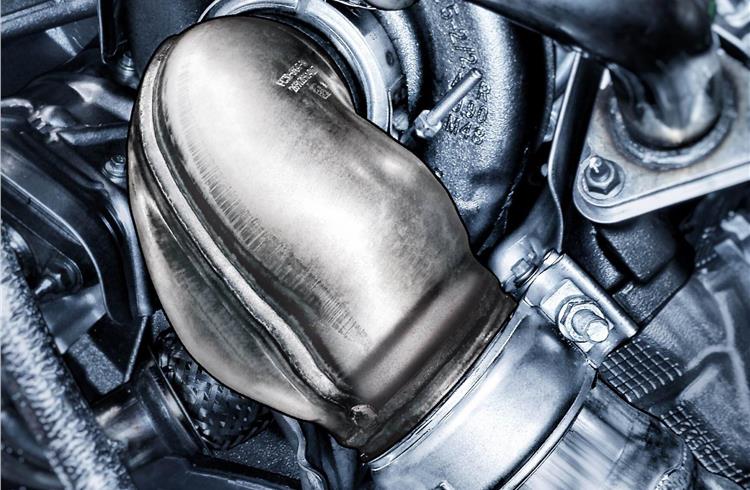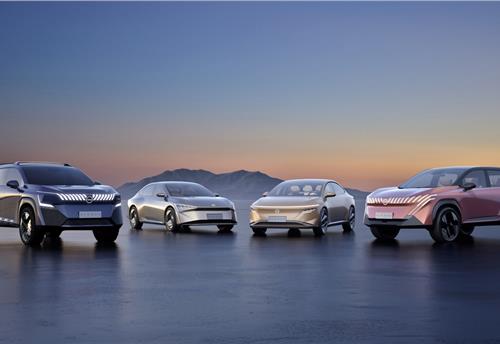Cobra head-shaped turbo exhaust helps Ford engine breathe better
While some might hold their breath seeing the fearsome shape of a king cobra, Ford engineers discovered that designing the turbo exhaust outlet, or downpipe, of the 6.7-litre Power Stroke V8 diesel like a cobra head helps the engine breathe easier.
While some might hold their breath seeing the fearsome shape of a king cobra, Ford engineers discovered that designing the turbo exhaust outlet, or downpipe, of the 6.7-litre Power Stroke V8 diesel like a cobra head helps the engine breathe easier.
Ford’s second-generation 6.7-litre Power Stroke V8 turbo diesel now boasts 440 horsepower, up from 400 horsepower, and 860 lb.-ft. of torque, up from 800 lb.-ft, across all Super Duty models from F-250 to F-450.
Ford is the only heavy-duty pickup truck manufacturer that designs and builds its own diesel engine and transmission combination, ensuring the powertrain will work seamlessly with all chassis components and vehicle calibrations – from concept to execution. This approach also enables Ford engineers to optimize the vehicle’s performance across the entire lineup.
A key Ford innovation on the original 6.7-litre Power Stroke V8 turbo diesel was its so-called reverse-flow layout. The advanced design places the exhaust inside the engine’s V-shape while the air intake is positioned on the outside of the V. This segment-exclusive design naturally improves a variety of attributes:
- Shorter airflow from the exhaust system to the turbocharger sitting between the engine’s cylinder banks improves turbo responsiveness – key to providing torque quickly to truck customers when they need it most
- Positioning the turbo inside the engine’s valley helps the engine efficiently use the hot temperatures, improving performance and efficiency, while also reducing noise, vibration and harshness
The hot-V design of the 6.7-litre Power Stroke – with its turbocharger bolted directly onto the compacted graphite iron engine block within the V of the V8 – provides exceptional packaging, structural advantages, and improved noise, vibration and harshness characteristics.
Getting the hot exhaust gases from the turbocharger out of the engine V with minimal obstruction to exhaust flow, which aids in generating power, is the job of the cobra head.
How it works
Any sharp turn or kink in an exhaust system can disrupt the flow and increase the pumping work an engine must do, reducing efficiency. The Cobra head acts like a widened, banked turn, allowing exhaust gases to flow smoothly through the 90-degree turn from the engine to the aftertreatment system and reduce backpressure. By reducing pumping losses, the design improves efficiency and allows greater torque production.
By applying hundreds of hours of advanced fluid dynamics computer modeling simulations to the design, Ford engineers were able to optimise the shape of the pipe bend.
“Fluid dynamics allowed us to precisely tune the curvature and width of the pipe to optimise exhaust gas flow,” said Robert Wade, engine air path technical leader. “It turns out that a downpipe shaped like a cobra head is the ideal design for air flow and breathability, which we validated through thousands of miles of durability testing.”
RELATED ARTICLES
Kia displays EV5 and Sonet SUVs for Chinese market
Kia has unveiled a number of key models and new technologies for Chinese customers at the 2024 Beijing International Aut...
Nissan targets growth in China, unveils four NEV concepts at Beijing Motor Show
The two EVs and two plug-in hybrids are a joint effort with Nissan’s local partner Dong Feng and aimed to better address...
Lamborghini unveils Urus SE ahead of Auto China 2024
Electric-only range of 60km helps reduce emissions by 80%.





 26 Aug 2014
26 Aug 2014
 3642 Views
3642 Views





 Autocar Pro News Desk
Autocar Pro News Desk




